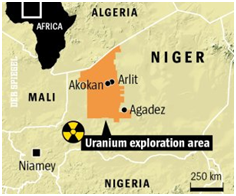
Introduction
When uranium was discovered in impoverished Niger in the 1960s, many thought the discovery would contribute to the economic and social development of the country. Unfortunately, it turned out to be a poisoned gift. Niger today is one of the poorest countries of the world, ranking 186th out of 187 countries in the Human Development Index of the United Nations Development Programme (UNDP) in 2012. More than 40% of children are underweight for their age, water and access to improved water sources is scarce and almost three quarters of the population are illiterate.
Uranium was found in the area of the Air Mountains in the Agadez region, north Niger, approximately 800 kilometres (km) North of Niamey, the capital of Niger, and 210 km north of the town of Agadez, one of the main settlements of the Tuareg, the indigenous people of the Sahara desert (Figure 1). The mining area being far away from any infrastructure, the French companies SOMAIR and COMINAK (both subsidiaries of COGEMA, the French state-owned uranium mining company today known as AREVA), created the towns of Arlit and Akokan (Figure 1). With no electricity provided, the companies built a coal-fired power plant approximately 190 km south of the mining areas, near the village of Tchirozerine, exploiting comparatively dirty coal. Today, people in the area (more than 100,000 inhabitants) are complaining about respiratory problems, birth defects, leukemia and cancer. Death rates linked to respiratory problems are twice that of the rest of the country. The environment will suffer from pollution for thousands years to come. The water is poisoned (Figure 2) and the aquifers drained, the soil and the air are contaminated, making a return to the traditional way of life of the local agro-pastoralists very difficult if not impossible.
Click here for the factsheet (4 pages):FS_030_Areva’s Uranium Mines
and here for further reading: FS_015_Niger Uranium



